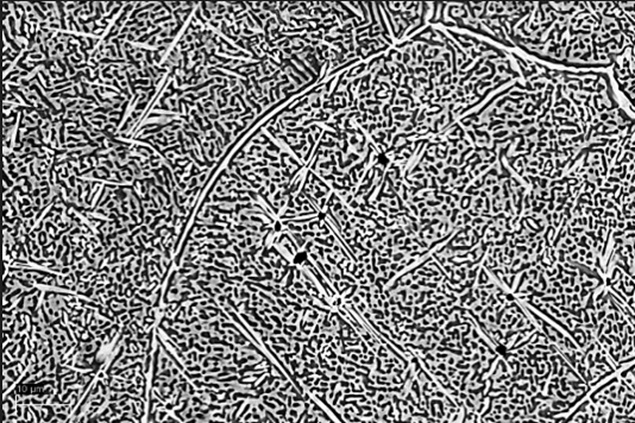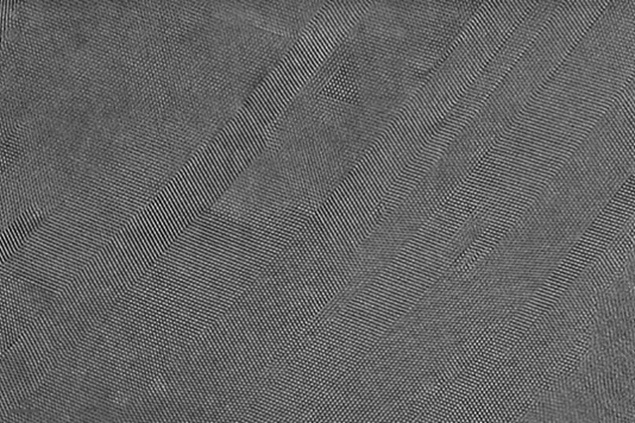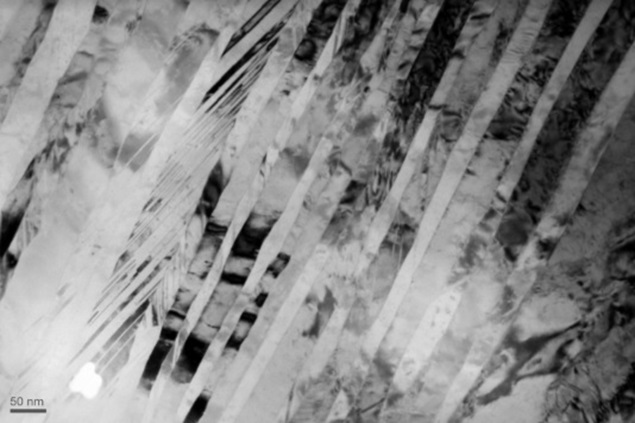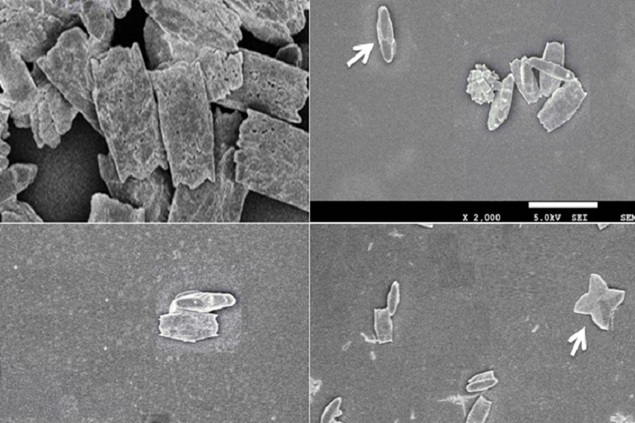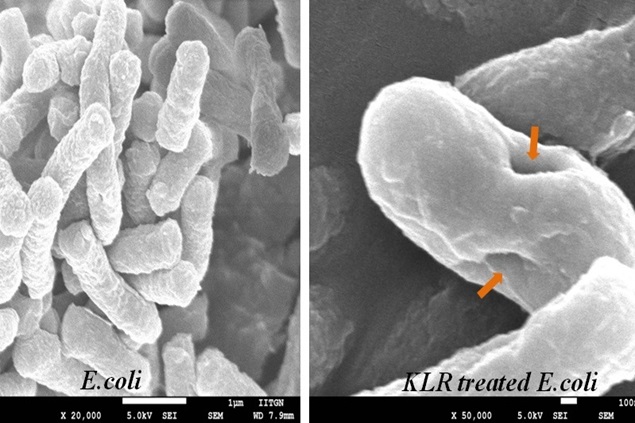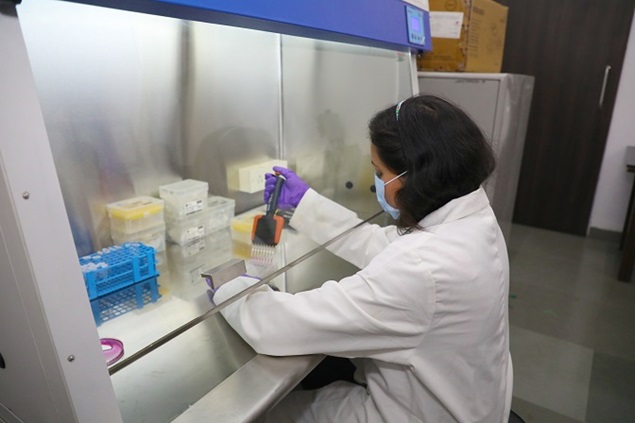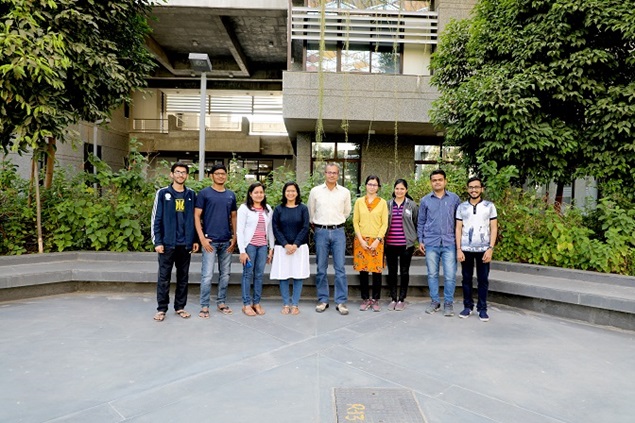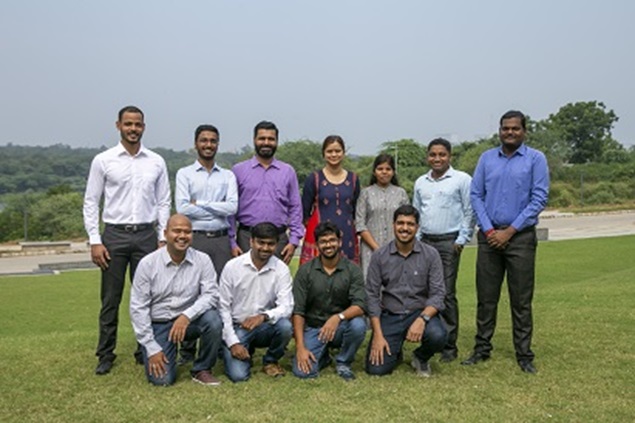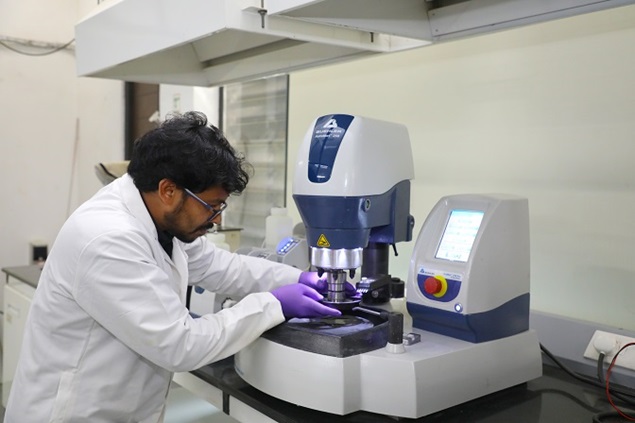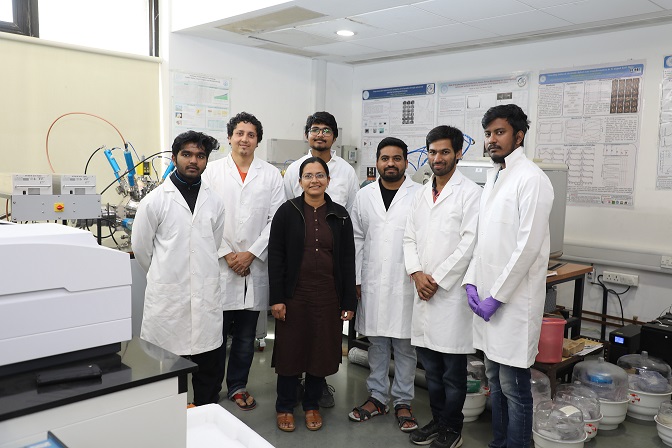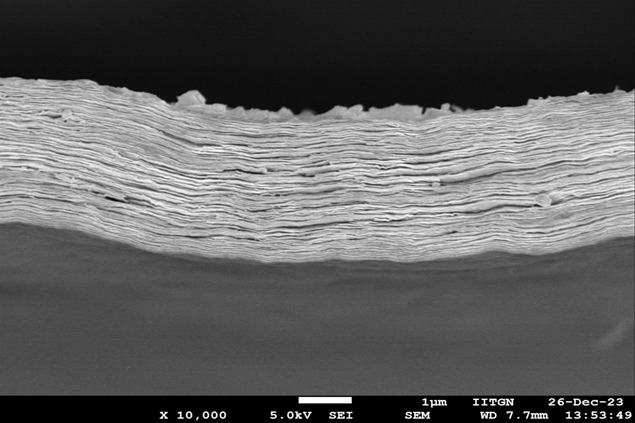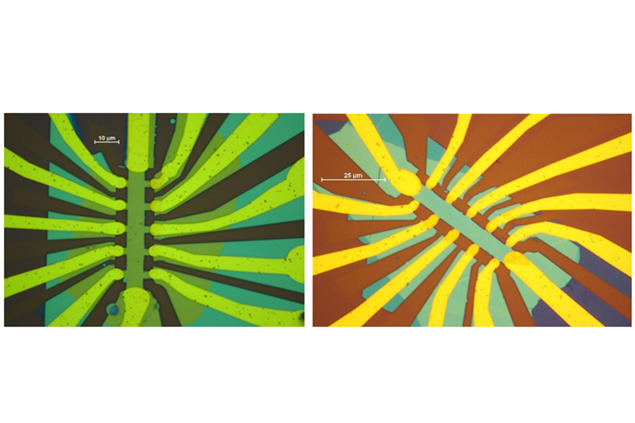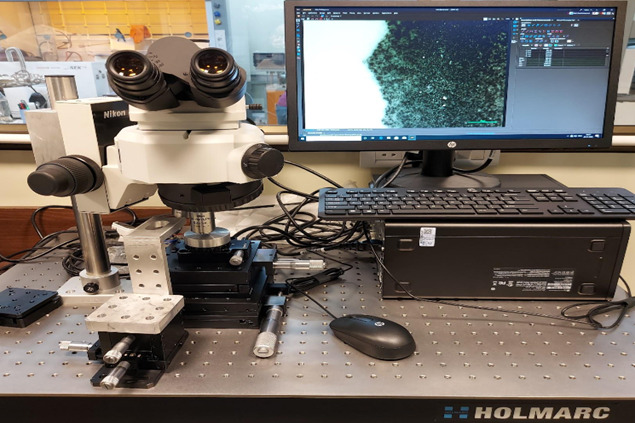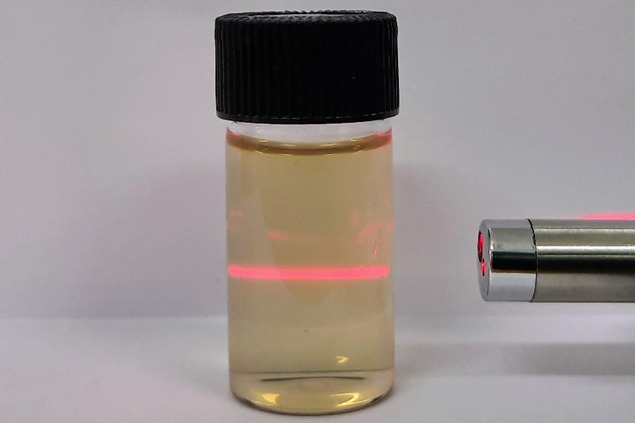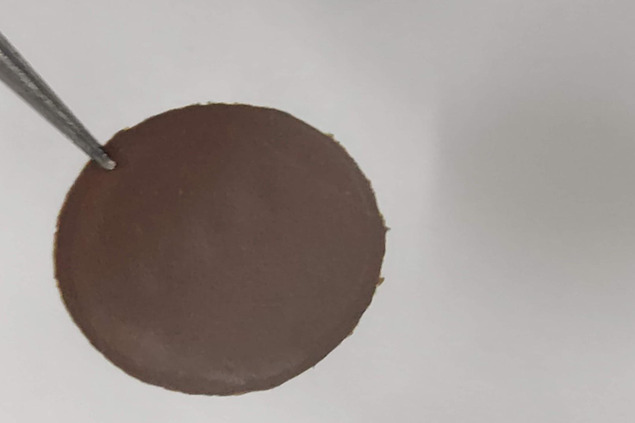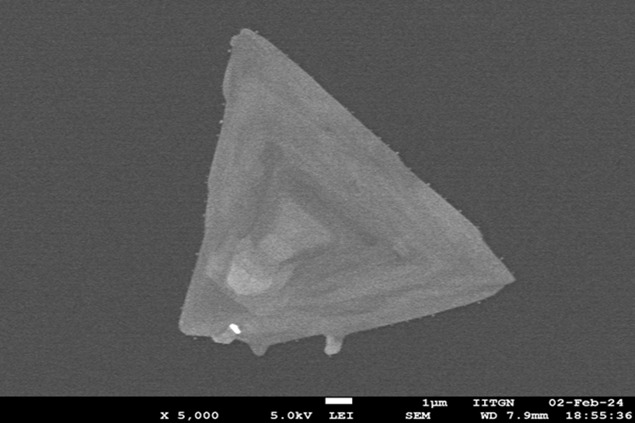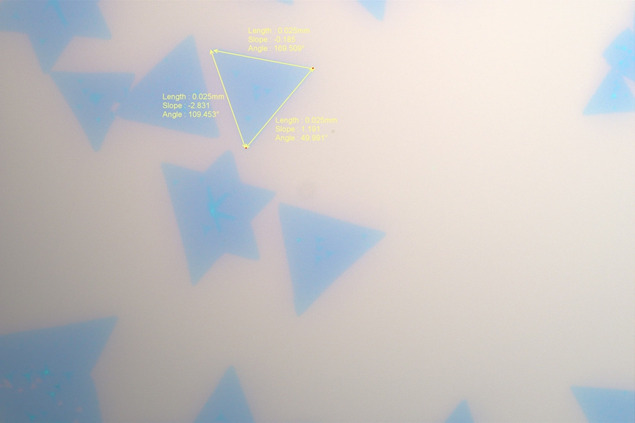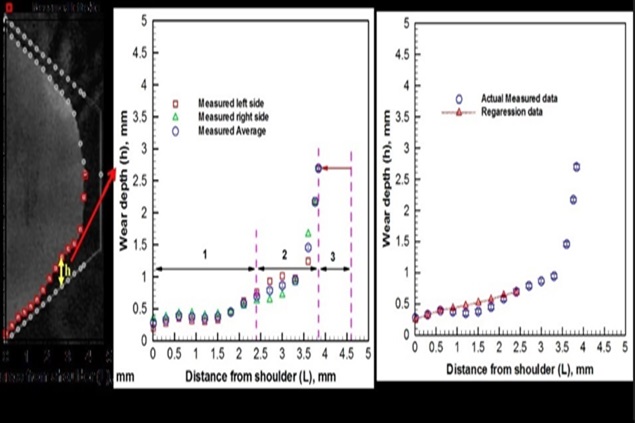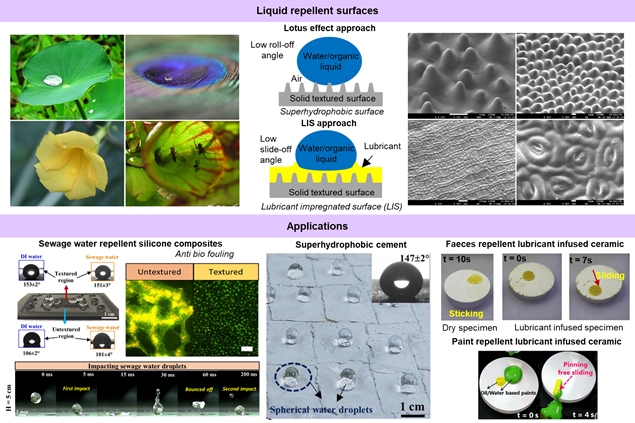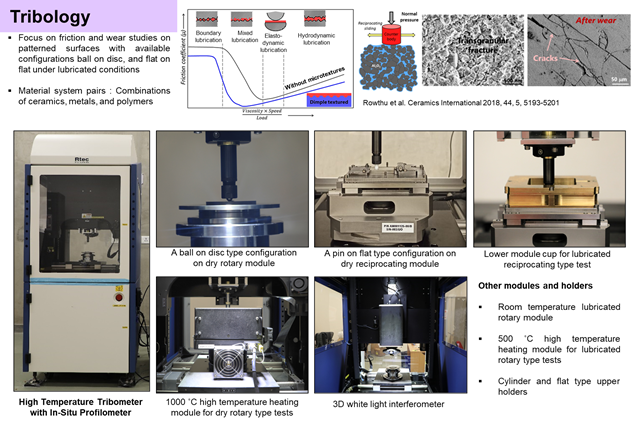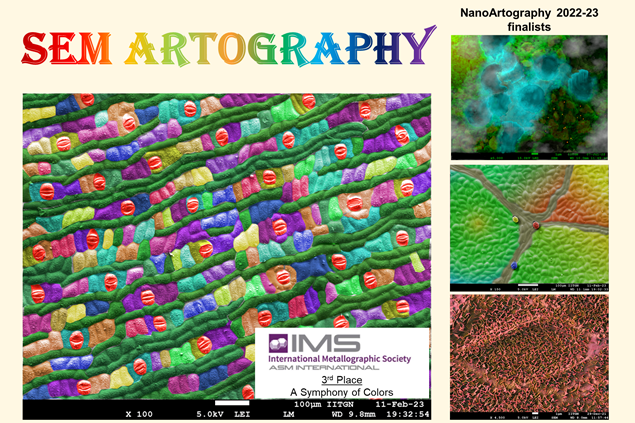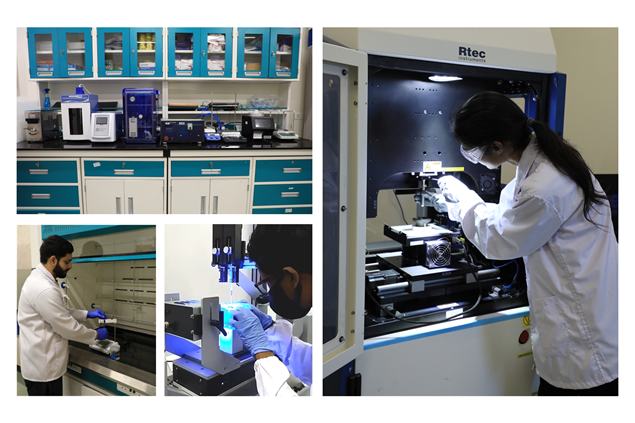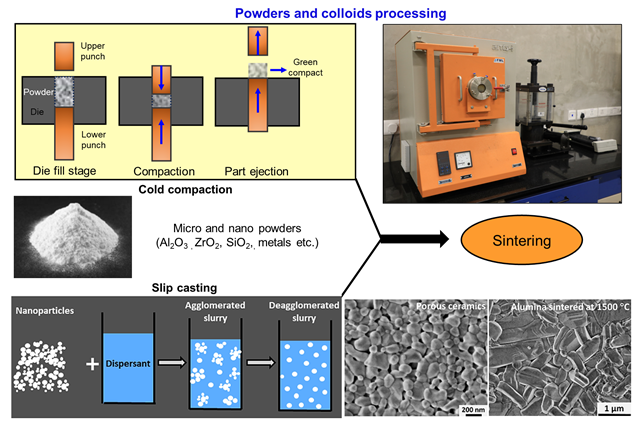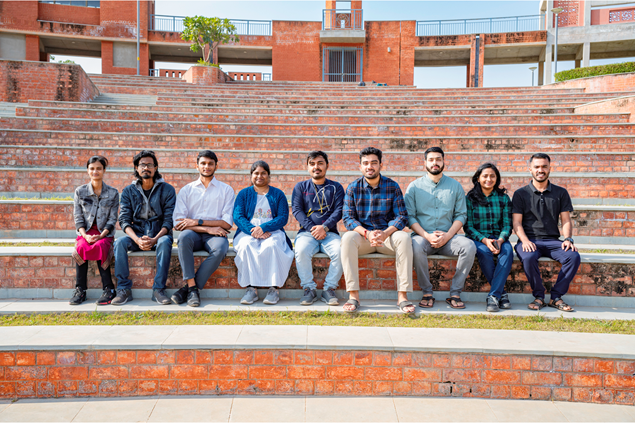Research Groups
-
AG
Materials Interfaces
PI: Dr. Abhay Raj Singh Gautam
- Contact Details:
- Email: agautam -AT- iitgn.ac.in
- Office: AB 11/306 C
- VOIP: 2477
Research Interests
● Interface structure and dynamics
Research Description
The Material Interfaces group at IITGN, which is lead by Prof Abhay Gautam and Prof Pradipta Ghosh, studies in the area of Interface Structure and Dynamics. For this, the team extensively use Physical Vapor Deposition (PVD) systems and Transmission Electron Microscopy based techniques among others. The team works on the following areas of research including; Solid Interfaces Structure, Interface Thermodynamics and Kinetics, and Grain Boundary Dynamics. The group currently have the following research facilities like PVD, LEED, AES, and Arc Melting units.
Recent Publications
1. Gautam A, Howe JM (2013) "A Method to Predict the Orientation Relationship, Interface Planes and Morphology Between a Crystalline Precipitate and Matrix: Part II - Application" Philosophical Magazine, 93 (25) 3472-3490.
2. Gautam A, Ophus C, Lançon F, Radmilovic V and Dahmen U (2013) "Atomic Structure Characterization of an Incommensurate Grain Boundary" Acta Materialia, 61(13) 5078-5086.
3. Gibb AL, Alem N, Chen J-H , Erickson KJ, Ciston J, Gautam A, Linck M, and Zettl A (2013) "Atomic Resolution Imaging of Grain Boundary Defects in Monolayer Chemical Vapor Deposition Hexagonal Boron Nitride" Journal of the American Chemical Society, 135(18) 6758-6761. -
AM
Biomolecular Materials Science Group
PI: Dr. Abhijit Mishra
- Contact Details:
- Email: amishra -AT- iitgn.ac.in
- Office: 11/309 D
- VOIP: 2422 / 2022
Research Interests
● Cell-penetrating peptides
● Intracellular bacterial targeting of nanoparticles and peptides
● Biodegradable polymers
● Antibacterial polymers
● Transport Phenomena
● Cellular uptake assessment of nanoparticlesRecent Publications
1. Prajapati, Deepak G., and Abhijit Mishra. "Long‐term and fast‐bactericidal activity of methacrylamide‐based copolymer for antibiofilm coatings and antibacterial wipes applications." Journal of Applied Polymer Science 141.1 (2024): e54745.
2. Bhadane, Prathmesh, and Abhijit Mishra. "The effect of Alkali treatment on Pineapple Leaf Fibers (PALF) on the performance of PALF reinforced rice starch biocomposites." Journal of Natural Fibers 19.16 (2022): 14235-14249.
3. Ratrey, Poonam, Bhaskar Datta, and Abhijit Mishra. "Intracellular bacterial targeting by a thiazolyl benzenesulfonamide and octaarginine peptide complex." ACS Applied Bio Materials 5.7 (2022): 3257-3268. -
AA
Advanced Materials Processing Research Group (AMPRG)
PI: Dr. Amit Arora
- Contact Details:
- Email: amitarora -AT- iitgn.ac.in
- Website: https://amit.people.iitgn.ac.in/
- Office: 11/308 B
- VOIP: 2424
Research Interests
● Numerical Modeling of Additive Manufacturing
● Modeling of Joining Processes
● Friction Stir Welding, Processing and Channeling
● Corrosion Studies of Surface Composites
● Aluminum Metal Matrix Composites
● Discrete Element Modelling
● Computational Alloy Design (CALPHAD)
Research Description
Dr. Amit Arora leads the Advanced Materials Processing Research Group at IIT Gandhinagar. The group's primary focus lies in the domain of numerical modelling of welding and joining processes, encompassing additive manufacturing processes of metals/polymers and polymer composites, as well as delving into the complexities of friction stir welding. Our research spans various critical aspects of FSW, including tool wear analysis, numerical modelling of dissimilar friction stir welding, and comprehensive examinations of mechanical and electrochemical properties in friction stir surface composites. Beyond this, the group also works on CALPHAD-based computational alloy design through thermodynamic and kinetic simulation.
Recent Publications
1. Srivastava, Nishkarsh, Amit Kumar Singh, Alok Kumar Kanungo, Amit Arora, Karaigowder Rajan, and Veerasamy Selvakumar. "Comparative microstructural and elemental analysis of iron artefacts from Kaveri valley archaeological sites." Archaeometry 65, no. 6 (2023): 1246-1259.
2. Sahoo, Sambit, Rajat Mishra, Nishkarsh Srivastava, and Amit Arora. "FEM simulation of pulsed laser welding of high-carbon alloy steel: using different heat source models." Transactions of the Indian Institute of Metals 76, no. 12 (2023): 3421-3427.
3. Das, Manojit, Arijit Jana, Astha Dixit, Rajat Mishra, Swapan Maity, R. Karthik, Shaik Salam Basha et al. "3D printing of tough nature inspired hierarchical architecture using chicken bone and eggshell biowaste for biomedical applications." Ceramics International 49, no. 17 (2023): 29274-29287. -
AB
Group Title
PI: Dr. Anagh Bhaumik
- Contact Details:
- Email: anagh.bhaumik -AT- iitgn.ac.in
- Linkedin: https://www.linkedin.com/in/anagh-bhaumik-ph-d-047a11100/
- Office: AB 11/305 B
Research Interests
● Synthesis of heavily doped carbon-based and 2D materials.
● Non-equilibrium synthesis of nanoarchitectures and thin films.
● Structure-property correlations.
● Manufacturing high-speed multifunctional electronic devices.
Research Description
Synthesis of new materials is the key to disruptive research and industrial applications. My fortes are (a) synthesis of heavily doped carbon-based and 2D materials by using highly non-equilibrium techniques, (b) structure-property correlations of these novel materials, and (c) manufacturing multifunctional electronic devices using these exciting materials. Highly non-equilibrium synthesis (pulsed laser deposition: PLD and pulsed laser annealing: PLA) can form high-quality thin films and nanoarchitectures of industrial significance. PLA will be used to introduce dopants beyond their thermodynamic solubility limits by solute trapping. In the PLA process, we will melt and subsequently quench the super undercooled state at an ultrafast rate thereby locking excess dopants in the material structure. The heavily doped materials will be integrated to manufacture high-speed multifunctional electronics: memory, spintronics, ferroelectrics, solar cells, sensors, diodes, transistors, and qubits for quantum computing.
Recent Publications
1. “Discovery of High-Temperature Superconductivity (Tc= 55 K) in B-Doped Q-Carbon” A. Bhaumik, R. Sachan, S. Gupta, J. Narayan 2017 (ACS Nano, 11, 11915 (2017)).
2. “High-Temperature Superconductivity in Boron-Doped Q-Carbon” A. Bhaumik, R. Sachan, J. Narayan 2017 (ACS Nano. 11, 5351 (2017)).
3. “Tunable charge states of nitrogen-vacancy centers in diamond for ultrafast quantum devices” A. Bhaumik, R. Sachan, J. Narayan 2019 (Carbon 142, 662 (2019)). -
EP
(Opto)electronics and Thin Films Laboratory (OTFL)
PI: Dr. Emila Panda
- Contact Details:
- Email: emila -AT- iitgn.ac.in
- Website: https://sites.google.com/iitgn.ac.in/otfl/home
- Office: 11/306 A
- VOIP: 2421
Research Interests
● Electronic materials
● Oxidation of magnetic materials
● Microstructure evaluation
● SIS Devices (Superconductor-Insulator-Superconductor)
● Material design for extreme environment
● Thermodynamics and kinetics of phase transformation in thin films
Research Description
Prof. Emila Panda heads the (Opto)electronics and Thin Films Laboratory (OTFL) at IITGN. To this end, her group has been experimentally investigating a range of semiconductor materials for various applications. Both the vacuum and the non-vacuum-based synthesis techniques have been adopted in her work. Moreover, these thin films are being fabricated by varying a range of process conditions, following which several experimental techniques are used to assess their detailed microstructure, optical and electrical properties. Materials that have been investigated in her group are, (Al, Mg, B)-doped ZnO, (Nb, Ta)-doped anatase TiO2 (as transparent conductors (TCO)), ZnO, ZnS, Zn(O)S (as n-type), SnS, Cu2-xS, Cu2SnS3 (as p-type semiconductors). The second focus of the research group is to understand the dry, thermal oxidation of various materials. Here, experimentally, oxide-films are grown by varying process conditions, following which a detailed investigation on the microstructure of these oxide-films are carried out using a range of experimental techniques. Both the thermodynamic and the kinetic approaches of the oxide-film growth are used to understand their microstructure as well as oxide growth kinetics. The investigated research projects under this category are, growth of ultra-thin crystalline and amorphous oxide films due to their thermal oxidation, thermodynamics of interfaces, oxidation of magnetostrictive materials and permanent magnets.
Recent Publications
1. Ravi Teja Mittireddi, Nisha Hiralal Makani, Ranjan Kumar Singh, Rupak Banerjee and Emila Panda, 2024. Heating/cooling-induced formation, dissociation and phase separation of CuFe2O4 during thermal oxidation of Sm2(Co, Fe, Cu, Zr)17 permanent magnet. Corrosion Science, 227: 111774 (pp. 11).
2. Rohit Dahule, Chetan C. Singh, Kenta Hongo, Ryo Maezono, and Emila Panda, 2022. Anomalies in the bulk and surface electronic properties of SnS: effects of native defects. Journal of Materials Chemistry C, 10, 5514 - 5525.
3. Krishna Manwani and Emila Panda, 2021. Thickness induced modifications in the valence, conduction bands and optoelectronic properties of undoped and Nb-doped anatase TiO2 thin films. Materials Science in Semiconductor Processing, 134: 106048 (pp.14). -
GK
2D Material Nanofluidics and Cryogenics Lab
PI: Dr. Gopinadhan Kalon
- Contact Details:
- Email: prafull.pandey -AT- iitgn.ac.in
- Group Webpage: https://sites.google.com/iitgn.ac.in/nanofluidicslab
- Office: AB 6/314 A
- VOIP: 2543
Research Interests
● Electronic and Membrane Materials
● 2D Material Based Nanofluidics & Energy Harvesting
● Membrane Science and Technology
● Cryogenic properties of Two-dimensional heterostructures
Research Description
Two of the most compelling problems humans facing today are the lack of clean water and the ever-increasing demand for energy. We are trying to find solutions by designing novel membranes consisting of angstrom-scale channels, which perform selective separation of molecules and ions. The choice of membrane material is driven by aspects such as low cost and also its ability to exhibit novel separation mechanisms that utilize less process energies. Our membrane designs are inspired by nature. We mostly use two-dimensional layered materials for membranes. Our intercalation strategies help us to design novel functional materials for membranes. The membrane fluidic channels are in the form of two-dimensional slits or laminates, nanotubes, and pores. The sizes of these membranes range from mm to inches. We model the atomic processes involved in the separation process using the COMSOL Multiphysics and ANSYS CFD simulation tools. Potential applications of these membranes are desalination, dye separation, isotope separation, fuel cell, energy generation, Li and other metals extraction.
We also fabricate micron-sized devices using optical lithography and thermal evaporator to understand the fundamentals of the transport processes. The electric field tuning of the transport is a fascinating area that we are pursuing with the aim of achieving fluidic field effect transistors. We have the ability to fabricate heterostructures of two-dimensional materials and are very excited to explore the avenue of twistronics. Our Cryogenic (400 K-1.5 K) facilities allow us to explore the electrical and magnetic transport properties of heterostructures in finding potential topological insulators, Weyl semimetals, topological superconductors, etc.Recent Publications
1. L. Saini, S.S. Nemala, A. Rathi, S. Kaushik, G. Kalon, Selective transport of water molecules through interlayer spaces in graphite, Nat. Commun. 13, 498 (2022).
2. A. Rathi, B. Dhal, S. S. Sarath, G. Kalon, Ion hydration-controlled large osmotic power with arrays of Angstrom scale capillaries of vermiculite, Cell Reports Physical Science 4, 101717 (2023).
3. A. Rathi, K. Singh, L. Saini, S. Kaushik, B. Dhal, S. Parmar, G. Kalon, Anomalous transport in angstrom-sized membranes with exceptional water flow rates and dye/salt rejections, Materials Today Nano 22, 100328 (2023). -
PP
Group Title
PI: Dr. Prafull Pandey
- Contact Details:
- Email: prafull.pandey -AT- iitgn.ac.in
- Linkedin: https://www.linkedin.com/in/prafull-pandey-91739955/
- Office: AB 11/308 D
- VOIP: 2317
Research Interests
● Alloy design
● High-temperature materials (Co-, Ni- and Fe-based superalloys)
● Electron microscopy
● Phase transformation
● Deformation mechanism
Research Description
The primary research thrust revolves around the design of advanced damage-resistant alloys tailored for diverse applications. Specifically, the focus is on the design and optimization of damage resistant superalloys, Cu-based, Al-based, Fe-based alloys, and multicomponent alloys. My research activities are centered on improving the physical understanding of micro mechanisms governing phase transformation, deformation, and damage evolution in these alloy systems. To facilitate this study, I employ state-of-the-art characterization techniques, including in-situ scanning electron microscopy (SEM), transmission electron microscopy (TEM), and channeling contrast imaging.
Recent Publications
1. S. Kumar, P. Pandey, K. Chattopadhyay, Influence of interfacial and strain energies on γ′ coarsening kinetics in complex concentrated alloys, Materialia, 33(2024), 102018
2. P. Pandey, M. Heczko, N. Khatavkar, N. Mazumder, A. Sharma, A. Singh. M. J. Mills, K. Chattopadhyay, On the faulting and twinning mediated strengthening and plasticity in a γʹ strengthened CoNi-based superalloy at room temperature, Acta Materialia, 252(2023), 118928
3. P. Pandey, A. Sawant, N. Baler, S. K. Makineni, K. Chattopadhyay, Effect of Ru addition on γ/γ′ microstructural stability in a low-density CoNi based superalloy, Scripta Materialia, 208 (2022), 114318. -
PG
Group Title
PI: Dr. Pradipta Ghosh
- Contact Details:
- Email: pradipta.ghosh -AT- iitgn.ac.in
- Website: https://www.iitgn.ac.in/faculty/mse/fac-pradipta
- Office: AB 11/305 A
- VOIP: 2558
Research Interests
● Alloy design with conventional melting and Electrodeposition
● Thermo-mechanical processing
● Mechanical behavior of materials
● Microstructure characterization.
Research Description
Our group mainly focuses on alloy design for structural applications. We take help of conventional melting and electrodeposition for preparing the alloys. The alloys are subjected to thermo-mechanical processes for microstructure engineering. We use advanced microscopy techniques such as XRD/Synchrotron , SEM-EBSD, TEM, APT for detailed microstructure characterization. The mechanical properties of the alloys are studied to understand their dependence on the microstructure. Our group also has interest in in-situ characterization of mechanical properties to capture the correlation with microstructure evolution.
Recent Publications
1. RT Mathew, S Singam, P Ghosh, SK Masa, MJNV Prasad, The defining role of initial microstructure and processing temperature on microstructural evolution, hardness and tensile response of Al-Mg-Sc-Zr (AA5024) alloy processed by high pressure torsion, J. Alloys Compounds, 901 (2022) 163548
2. Kapp MW, Renk O, Ghosh P, Leitner T, Yang B, Pippan R, Plastic strain triggers structural instabilities upon cyclic loading in ultrafine-grained nickel, Acta Materialia, 200 (2020) 136-147
3. Renk O, Ghosh P, Sabat RK, Eckert J, Pippan R, The role of crystallographic texture on mechanically induced grain boundary migration, Acta Materialia, 200 (2020) 404-416 -
RR
Computational Molecular Engineering Group
PI: Dr. Raghavan Ranganathan
- Contact Details:
- Email: rraghav -AT- iitgn.ac.in
- Linkedin: https://www.linkedin.com/in/raghavan-ranganathan-169317ab/
- Office: AB 11/308 A
- VOIP: 2557
Research Interests
● Atomistic/Molecular simulations of structure-property relations
● AI and ML applications in computational materials design
● Dynamics of soft matter
● Thermodynamics and kinetics of phase transformations in materials
● Materials under extreme conditions
● Biomimetic approaches for materials design
Research Description
The Computational Molecular Engineering Group (C-MEG) focuses on large-scale atomistic and molecular simulations to uncover novel structure-property relations in materials. A wide variety of materials spanning porous materials, 2D materials, glasses, alloys, natural materials (and their biomimetic counterparts) and polymer nanocomposites are of interest, with the key question on how structure affects the properties at the nanoscale. We probe various properties such as mechanical, thermal, mass transport and chemical reactivity, to name a few. More recently, the C-MEG group has started using AI and ML techniques for materials design and development for various applications.
Recent Publications
1. Singh, Param Punj, and Raghavan Ranganathan. "Mechanical and Viscoelastic Properties of Stacked and Grafted Graphene/Graphene Oxide–Polyethylene Nanocomposites: A Coarse-Grained Molecular Dynamics Study." ACS Omega (2024).
2. Lahkar, Simanta, and Raghavan Ranganathan. "Competing mechanisms govern the thermal rectification behavior in semi-stochastic polycrystalline graphene with graded grain-size distribution." Carbon 218 (2024): 118638.
3. Singh, Param Punj, and Raghavan Ranganathan. "Superior Protection Conferred by Multi-Layered Graphene–Polyethylene Nanocomposites under Shock Loading." ACS Applied Engineering Materials (2023). -
SR
Functional Materials Laboratory (FML)
PI: Dr. Sriharitha Rowthu
- Contact Details:
- Email: sriharitha.rowthu -AT- iitgn.ac.in
- Group Webpage: https://www.fml-iitgn.com
- Linkedin: https://www.linkedin.com/in/functional-materials-laboratory-fml-145127237
- Office: AB 11/309 B
- VOIP: 2560
Research Interests
● Colloidal processing of ceramics of polymers
● Dewetting Surfaces
● Surface Micro and Nano Patterning (Lithography)
● Tribology of Lubricated Surfaces
● Transport Phenomena
Research Description
FML is an interdisciplinary research group that focuses on the development of porous materials and surface micro and nano patterns by wet chemistry routes and lithography processes to fabricate liquid repellent surfaces and wear-resistant surfaces. Primarily, both the superhydrophobic and slippery surfaces are being prepared for studying their long-term durability in different weather conditions, wear/scratch resistance and self-healing properties. One of our main visions is to provide innovative solutions for marine/underwater applications, medical industries, food industries, paint industries, sanitation to repel real-life liquids and microorganisms such as bacteria by using Nature Inspired Strategies. We utilize the concepts and first principle models of mass and momentum transport in designing and understanding the underlying dewetting mechanisms and self-healing mechanisms. Typical materials we have been working with include polydimethylsiloxanes (PDMS), high density polyethylene (HDPE), alumina, zirconia, cement and ceramic composites.
Recent Publications
1. Sriharitha Rowthu, Srinadh Mattaparthi, Erdem Siringil, Patrik Hoffmann, “Sewage Water-Repellent PDMS and Magnetic Silicone Composites: Lab to Commercialization”, ACS Applied Polymer Materials, 2023, 5, 6161. Featured on journal Cover Page and ACS Headline News.
2. Srinadh Mattaparthi, Dhrmendra Sablaniya, Srinithi Rajendran, Amit Singh, Sreeram Kalpathy, Sriharitha Rowthu, “Non-toxic Self-cleaning Large Area Cement Blocks Fabrication by Biomimicking Superhydrophobic Periwinkle Flowers”, Colloids and Surfaces A: Physicochemical and Engineering Aspects, 2022, 647, 129112.
3. Deepak Prajapati, Sriharitha Rowthu, “Unravelling anisotropic wettability of Banana leaves with water and human urine”, Surfaces and Interfaces, 2021, 29, 101742. -
SM
Bio-Nanomaterials Group (BNMG)
PI: Dr. Superb Misra
- Contact Details:
- Email: smisra -AT- iitgn.ac.in
- Website: BNMG Lab
- Office: AB 11/306 B
- VOIP: 2467
Research Interests
● Biomaterials and Tissue Engineering
● Metal Oxide Frameworks (MOFs)
● Nanomaterials
● Nanotoxicology
● Materials safety
Research Description
Bio-Nanomaterials Group (BNMG) is an interdisciplinary research group, led by Prof. Superb Misra, which focuses on the application of materials science for biological systems. BNMG is conducting research on exploiting the uniqueness of engineered nanomaterials for use in biomedical applications (guided regeneration, nanomedicine). In addition, research activities are also directed towards understanding the intrinsic properties of novel materials and using them to get a predictive biological impact, for cellular and environmental research.
Recent Publications
1. Singh S et al. Enhanced therapeutic action of Trastuzumab loaded ZnxMn1−xFe2O4nanoparticles using a pre-treatment step for hyperthermia treatment of HER2+ breast cancer. Colloids and Surfaces B: Biointerfaces. 2023. 232, 113579
2. Malvi B, et al. Development of isotopically labelled 65Cu embedded PMMA-65CuO nanocomposites for detection and quantification of PMMA bone cement degradation at trace levels. Materials Today: Comm. 2023. 36, 106849.
3. S Singh, et al. Synergistic Effect of Yb3+, Tm3+, Nd3+ Doped NaYF4 Nanoparticles and MoS2 Nanosheets for Enhanced Photocatalytic Dye Degradation under Visible Light. ACS App. Nano Mater. 2023, 6,10441.

